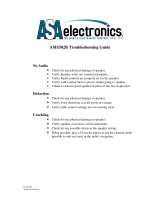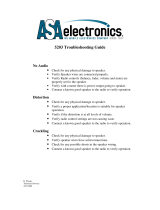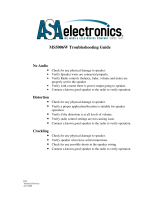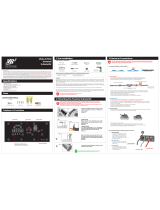Blaupunkt PCA460 User manual
- Category
- Car audio amplifiers
- Type
- User manual
Blaupunkt PCA460 is a 4/3/2-channel amplifier with a maximum power output of 300W and a total harmonic distortion of 0.1% at full power. It features a subsonic filter, separate front/rear or left/right gains, and high, low, and reverse voltage protection. The amplifier also has a damping factor of >100 and a frequency response of 20 - 30,000 Hz. Additionally, it has a bass boost, variable input impedance, and input signal voltage control range of 0.3 - 6.0 vrms. The amplifier's current draw at 13.8 VDC is 34 A at full rated power, unbridged, and 17 A at 33% rated power, unbridged.
Blaupunkt PCA460 is a 4/3/2-channel amplifier with a maximum power output of 300W and a total harmonic distortion of 0.1% at full power. It features a subsonic filter, separate front/rear or left/right gains, and high, low, and reverse voltage protection. The amplifier also has a damping factor of >100 and a frequency response of 20 - 30,000 Hz. Additionally, it has a bass boost, variable input impedance, and input signal voltage control range of 0.3 - 6.0 vrms. The amplifier's current draw at 13.8 VDC is 34 A at full rated power, unbridged, and 17 A at 33% rated power, unbridged.













-
 1
1
-
 2
2
-
 3
3
-
 4
4
-
 5
5
-
 6
6
-
 7
7
-
 8
8
-
 9
9
-
 10
10
-
 11
11
-
 12
12
-
 13
13
Blaupunkt PCA460 User manual
- Category
- Car audio amplifiers
- Type
- User manual
Blaupunkt PCA460 is a 4/3/2-channel amplifier with a maximum power output of 300W and a total harmonic distortion of 0.1% at full power. It features a subsonic filter, separate front/rear or left/right gains, and high, low, and reverse voltage protection. The amplifier also has a damping factor of >100 and a frequency response of 20 - 30,000 Hz. Additionally, it has a bass boost, variable input impedance, and input signal voltage control range of 0.3 - 6.0 vrms. The amplifier's current draw at 13.8 VDC is 34 A at full rated power, unbridged, and 17 A at 33% rated power, unbridged.
Ask a question and I''ll find the answer in the document
Finding information in a document is now easier with AI
Related papers
-
Blaupunkt VA4100 User manual
-
Blaupunkt PCA2120 User manual
-
Blaupunkt VA1400 User manual
-
Blaupunkt BH Series Bluetooth Headphone Owner's manual
-
Blaupunkt PA2100 User manual
-
Blaupunkt GTA 11200 User manual
-
Blaupunkt PCA450 User manual
-
Blaupunkt PCA 250 User manual
-
Blaupunkt MPA160 User manual
-
Blaupunkt XLf 150 A User manual
Other documents
-
 ASA Electronics JXA3RTW User guide
ASA Electronics JXA3RTW User guide
-
 ASA Electronics MS5006W User manual
ASA Electronics MS5006W User manual
-
 ASA Electronics MS5006W User manual
ASA Electronics MS5006W User manual
-
Orion ORLOC60 Owner's manual
-
Hertz ML Power 5 Owner's manual
-
Hertz ML POWER 4 Mille ML Power 4-Channel Car Amplifier User manual
-
Orion ORGLI100 Owner's manual
-
 Virtual Reality VRA1.0PSW User manual
Virtual Reality VRA1.0PSW User manual
-
Metra 44-UA200 Operating instructions
-
Altronix ALSD1 Datasheet
















